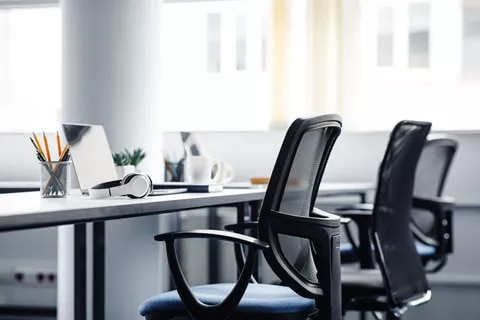The future of the corporate office in a post-pandemic world

Social distancing has become one of the norms of everyday life since the outbreak of Covid-19, forcing workplaces to revaluate the proximity and density of workers in the corporate office. The adoption of remote work has been pivotal in how we view the the modern corporate office particularly its functionality. Will the modern corporate office design be different? Will remote work continue? Read on to for our guide on everything you need to know about the future of the corporate office and how it's evolving.
The Pre-Covid Corporate Office
In less uncertain times in a pre-covid world, one of the biggest benefits of a corporate office was that employees had defined roles, teams and assigned seating in office spaces – a kind of constant and comfort of knowing there was a ‘base camp’ to come back to.
The corporate office is where we spend a large proportion of our waking hours amongst colleagues and contributing to the tasks and demands of our jobs. But since the emergence of remote work and teleworking, work responsibilities and leisure time have become far more blurred and less defined when our home environment is also our work environment.
The future of the corporate offices has ultimately forced companies to confront how they can galvanise their employees remotely with workplace planning but still balancing the benefits workers receive when they are at work, in an office.
What Does the Corporate Office Look Like Now?
Since the onset of the pandemic, businesses have the onus to protect their workers and to manage the safety of employees without risking their health. Covid-19 has not only disrupted the corporate workplace but has also changed our outlook on it.
In many countries, working from home has been the main stay and employees have not seen the inside of their corporate offices, since the outbreak of Covid-19. The corporate office has changed irrevocably, and businesses have adapted so that employees work from home indefinitely.
Whilst, more locally in Australia, where the spread of Coronavirus has been more subdued, the corporate office has adopted a host of new methods to promote safety in the workplace: social distancing at 4m² per person, increased cleaning and sanitisation as well as hand sanitizer liberally supplied in offices.
Some companies have implemented a hybrid workplaces approach where employees work partially at home and partially in the office, meaning that a corporate office might have less than 50% capacity at any given time. This strategy means that it is safer for everyone as the density of workers occupying a shared space is reduced.
The utility of the corporate office has also shifted where companies are now considering downsizing the office space they need- businesses simply don't need as many employees in the office, particularly to comply with health protocols of social distancing. This means that they can lower their overhead costs by utilising a smaller office space.
Progressive organisations like Spotify have altogether declared that employees can continue to work from home permanently after the pandemic is over. If they prefer to come into the office they may do so with an option that even workers who may not be near a Spotify hub, will have a coworking membership organised for their location.
Are there still benefits to the Corporate Office?
Although there will be a lot of changes in the modern corporate office, there will still be a lot of benefits that you should consider and keep in mind. One of the true upsides to the corporate office is that employees can enjoy more flexibility and an increased work life balance. They can enjoy the flexibility of working at home in their comfort zone and reduce the demand for always having to be in the office, commuting five days a week. However, they can still come in for tasks that might require a higher level of social interaction e.g. training and development, important meetings or workshopping new ideas in hack sessions.
Fostering a culture of flexibility can inspire more productivity in employees and has shown to have positive effects on long-term retention as well as increased work satisfaction and happiness. An Owl Labs 2019 study found that are remote workers or those who have the option of working remotely partially, are13% more likely than onsite workers to stay in a role over an extended period of time.
Another benefit of the modern corporate office is the social connectivity it provides for workers between team members, managers as well as cross-team communication. There is still a strong inherent human need to be around others that is intrinsic to wellbeing, with many reporting that loneliness and social isolation is a distinct downside to remote work.
Although many companies have adopted virtual collaboration through zoom and other tools, workers list that ‘people’ were what they missed the most about the corporate office. When asked to rank the most important factors for coming into the office, a Gensler Work From Home survey found that meetings with colleagues, socialising with others and impromptu face-to-face interactions were the most highly rated reasons.
Ultimately, there are a lot of benefits to consider with the modern corporate workspace in light of the disruptions of covid-19. These changes have created new expectations of businesses for managing safety as well as considering the social well being of employees and having at least a physical location for face-to-face interactions. What is certain is that the pandemic has in many ways dictated remote work but looking ahead the big question that businesses must decide is whether to keep a flexible model where workers can make arrangements for remote work and on-site work.





